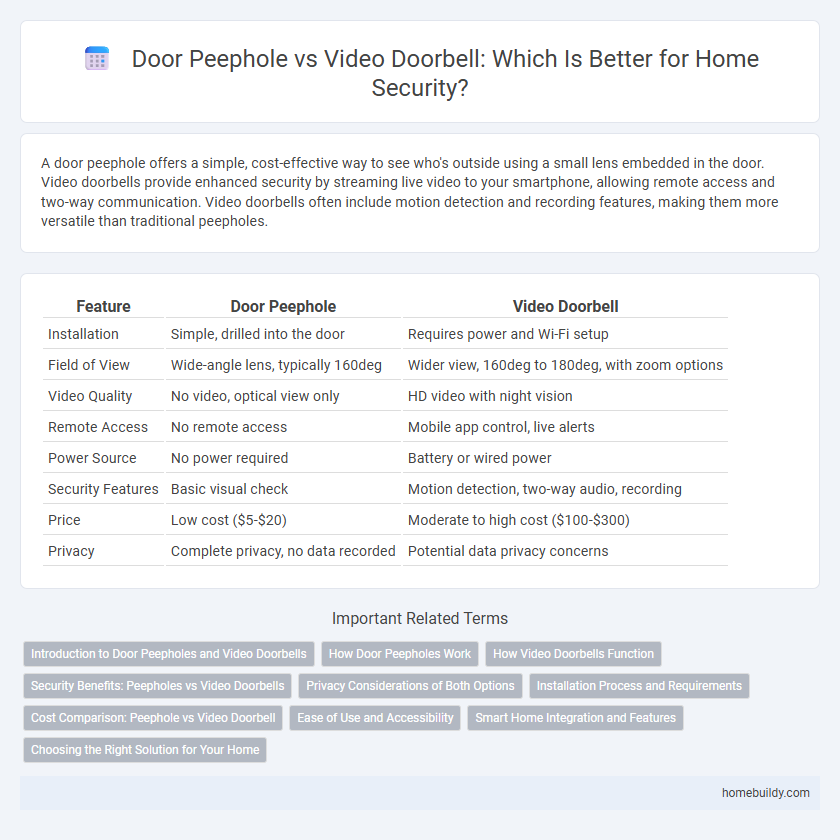A door peephole offers a simple, cost-effective way to see who's outside using a small lens embedded in the door. Video doorbells provide enhanced security by streaming live video to your smartphone, allowing remote access and two-way communication. Video doorbells often include motion detection and recording features, making them more versatile than traditional peepholes.
Table of Comparison
| Feature | Door Peephole | Video Doorbell |
|---|---|---|
| Installation | Simple, drilled into the door | Requires power and Wi-Fi setup |
| Field of View | Wide-angle lens, typically 160deg | Wider view, 160deg to 180deg, with zoom options |
| Video Quality | No video, optical view only | HD video with night vision |
| Remote Access | No remote access | Mobile app control, live alerts |
| Power Source | No power required | Battery or wired power |
| Security Features | Basic visual check | Motion detection, two-way audio, recording |
| Price | Low cost ($5-$20) | Moderate to high cost ($100-$300) |
| Privacy | Complete privacy, no data recorded | Potential data privacy concerns |
Introduction to Door Peepholes and Video Doorbells
Door peepholes provide a simple, mechanical way to view visitors through a small lens embedded in the door, offering privacy without electronic components. Video doorbells incorporate digital cameras and connectivity features, allowing real-time video streaming and remote communication via smartphones. While door peepholes excel in reliability and privacy without power requirements, video doorbells enhance security through monitoring, recording, and interactive functions.
How Door Peepholes Work
Door peepholes work by using a fisheye lens to provide a wide-angle view of the area outside the door, allowing homeowners to see visitors without opening the door. Unlike video doorbells that use electronic cameras and Wi-Fi connectivity, peepholes rely solely on optical principles, requiring no power source or network connection. This simple mechanism ensures privacy and security through direct visual access while eliminating risks associated with digital surveillance.
How Video Doorbells Function
Video doorbells function by using a built-in camera to capture live video footage of visitors at the door, which is streamed directly to a smartphone or connected device via Wi-Fi. Equipped with motion sensors, these devices can send real-time alerts and enable two-way audio communication, enhancing home security and convenience. Unlike traditional door peepholes, video doorbells provide remote visibility and recording capabilities, allowing homeowners to monitor access even when they are not physically present.
Security Benefits: Peepholes vs Video Doorbells
Door peepholes offer reliable, low-tech security by allowing residents to visually verify visitors without electronic vulnerabilities or power dependency. Video doorbells provide advanced security features such as real-time remote monitoring, motion detection alerts, and video recording, enhancing situational awareness and evidence collection. However, peepholes eliminate risks associated with hacking and data breaches, making them a secure choice for privacy-conscious homeowners.
Privacy Considerations of Both Options
Door peepholes offer a high level of privacy by allowing visual identification without transmitting or storing any data, eliminating risks of hacking or unauthorized access. In contrast, video doorbells capture and sometimes store footage, raising potential privacy issues due to cloud storage vulnerabilities and real-time monitoring. Choosing between these options depends on balancing privacy concerns with the convenience of remote access and surveillance features.
Installation Process and Requirements
Door peepholes require minimal installation, typically needing just a drill to create a small hole in the door for mounting the lens, making them suitable for most standard door thicknesses without additional wiring. Video doorbells, in contrast, often necessitate professional installation involving electrical wiring or battery setup, Wi-Fi connectivity, and mounting that may require wall anchors or power tools. The basic door peephole offers a quick, low-cost setup with no power source needed, while video doorbells demand more complex installation but provide enhanced security features and remote access.
Cost Comparison: Peephole vs Video Doorbell
Traditional door peepholes offer an affordable security solution, usually costing between $5 and $20 for basic models, with no ongoing fees. Video doorbells, priced from $100 to $250, often require monthly subscription plans ranging from $5 to $30 for cloud storage and advanced features. For budget-conscious homeowners, peepholes provide a one-time investment, while video doorbells entail higher upfront costs and recurring expenses.
Ease of Use and Accessibility
Traditional door peepholes offer immediate, battery-free viewing without requiring technological proficiency, making them highly accessible for all age groups. In contrast, video doorbells often depend on smartphone apps and internet connectivity, which can pose usability challenges for less tech-savvy users or those with limited access to digital devices. The simplicity of a peephole ensures quick identification of visitors without navigating complex interfaces or relying on external power sources.
Smart Home Integration and Features
Door peepholes offer basic visibility and privacy by allowing users to view visitors through a small lens without electronic components, ensuring simplicity and low maintenance. Video doorbells integrate advanced smart home features such as mobile app alerts, two-way audio, motion detection, and cloud recording, enabling remote monitoring and interaction with visitors. Smart home integration in video doorbells enhances security by connecting to platforms like Amazon Alexa, Google Home, or Apple HomeKit, providing seamless automation and real-time access to footage.
Choosing the Right Solution for Your Home
A door peephole provides a simple, cost-effective way to see visitors without opening the door, ideal for those seeking privacy and minimal setup. Video doorbells offer advanced security features like two-way audio, motion detection, and remote viewing via smartphone apps, enhancing home safety with real-time alerts. Choosing between a traditional door peephole and a video doorbell depends on your security needs, budget, and preference for technological integration.
door peephole vs video doorbell Infographic

 homebuildy.com
homebuildy.com